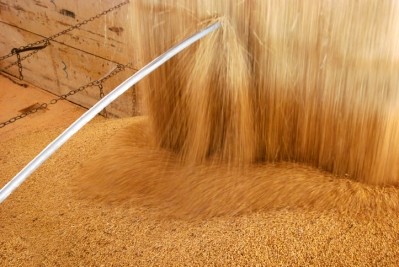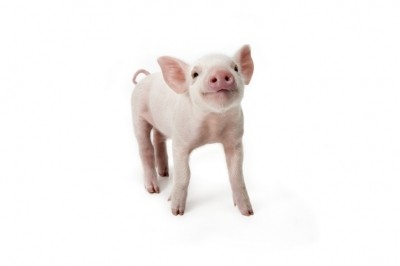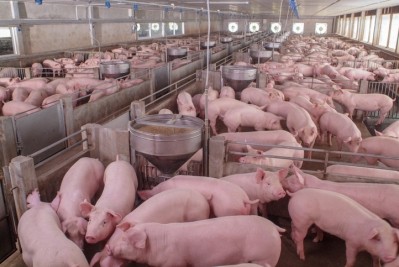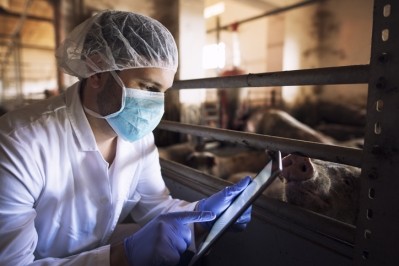How contaminated with ASFV does feed have to be to infect pigs?

The authors said they also observed that unprocessed liquid porcine plasma (LPP) may contain inherent properties that could diminish the infectious capacity of ASFV in feed.
"In our studies, we found that ASFV inoculated liquid unprocessed porcine plasma was infective when administered either by intramuscular injection or by oral gavage, but not when mixed with commercial feed. We found that complete mash feed contaminated with either 104.3 or 105.0 TCID50 ASFV daily was not infective when fed to naïve pigs for 14 consecutive days. Our data suggests that the minimum infectious dose of ASFV in feed is much higher than previously reported, at least with ASFV-spiked liquid porcine plasma (LPP)," Javier Polo, vice-president, research and development, APC, Spain, told FeedNavigator.
The research was carried out in conjunction with porcine plasma producer, APC. The company provided funding for the study, gave support in the form of salaries for certain authors, but it did not have any additional role in the study design, data collection and analysis, decision to publish, or preparation of the manuscript.
Rationale behind study
ASFV is today a significant threat and trade restriction to the global swine industry.
Contaminated feed and porcine origin feed ingredients have been considered risk factors for the spread of African Swine Fever, said the team, citing research by Dr Scott Dee and his colleagues at Pipestone Applied Research in the US, whose work has demonstrated that ASFV can survive for up to 30 days under conditions of a transboundary simulation model.
They also referenced research by Dr Megan Niederwerder and colleagues at Kansas State University showing that a minimum infectious dose (MID) of 104 50% tissue culture infectious dose (TCID50) mixed into feed and administered as a single feeding was enough to infect 40% of exposed pigs. Extrapolating from this data, those authors predicted that 10 exposures by feeding would result in 100% of the pigs becoming infected
Meanwhile, the authors noted that the prevalence of ASF globally has increased the fear that infected asymptomatic pigs may not be detected during antemortem inspection and could be slaughtered: “Porcine origin feed ingredients could then be unknowingly contaminated with tissues from these pigs.”
Methodology
Based on this premise and its potential impact on viral transmission, the authors said they designed two studies to determine if commercially collected unprocessed LPP contaminated with blood from ASFV infected pigs blended with feed (at infectious doses of 104 or 105 TCID50) daily for 14 consecutive days would be able to cause ASFV infection in pigs.
Instead of spray dried porcine plasma (SDPP), which is normally used in feed diets, they decided to use LPP to avoid the inactivation effect of the spray-drying process on ASFV.
Commercially collected LPP was mixed with the serum from an ASFV experimentally infected pig, they explained.
The contaminated liquid plasma was mixed on commercial feed.
Trials
In study 1, pigs weaned at four to five weeks of age were divided into two groups of 10 pigs each. After an overnight fast, pigs were fed daily with 110g of their respective treatment (either the positive or negative control feed) daily for 14 consecutive days, said the researchers.
After that 14-day feeding period, both groups of animals were provided non-inoculated feed and observed for signs of infection for five more days.
On day 19, two pigs from each group were euthanized and necropsied. As no fever or clinical signs were observed, the team said Study I was extended to determine if the inoculum could be infectious by other routes of application.
On day 20, four of the positive control pigs were inoculated by intragastric tube (IG) with 50 mL of the LPP spiked with ASFV (single dose providing 105.1 TCID50/pig), and the other four pigs from this group were injected intramuscularly (IM) with 10 mL of the ASFV inoculated LPP (single injection providing 104.3 TCID50/pig), they reported.
The same procedures were done for the negative control group, using non-inoculated LPP, according to the paper.
Pigs were monitored for clinical signs daily for eight days after IM or IG administration and all surviving pigs were euthanized on day 28 of the study, wrote the authors.
In study 2, only the positive control treatment was tested again with another group of 10 pigs weaned at four to five weeks of age. The pigs were provided feed mixed with ASFV inoculated LPP as for 14 consecutive days, except that the concentration of ASFV administered daily on feed was 105.0 TCID50/pig/day, said the team.
There was a 9-day observation following the treatment period. On day 23, six pigs received 50 mL of ASFV inoculated LPP by IG (single dose providing 105.7 TCID50/pig) to determine if the ASFV inoculated LPP contained infective virus. The remaining pigs were not administered IG gavage of the positive control LPP but remained the same pen as the IG pigs. All animals were euthanized on day 32, they added.
Findings
All pigs administered feed mixed with LPP, both the positive and negative controls, remained healthy for the 14-day trial period and during the subsequent five or 9 day observation period (in both studies 1 and 2, respectively), found the team.
Polo said the findings of this study contrasted with the results in the paper from Niederwerder et al, referenced earlier.
"There were some experimental procedure differences between our feeding study and those reported by Niederwerder et al (2019) that may account for the different results obtained.
"In the study conducted by Niederwerder et al (2019) they added 10 mL of virus inoculum at a specified dose (ranging from 103 to 108 TCID50) to 100g of feed in a bottle and allowed it to absorb for 30 seconds, then homogenized it by rolling and gently mixing the bottle by hand. Designated specific doses provided in only one feed exposure were used in seven replications using five different pigs per replication. They used a plant-based feed of known formulation. Unfortunately, no data were reported about the virus concentration in the infected feed to confirm the dose administered for each replica.
"In our study, 100 mL of the inoculum (liquid porcine plasma spiked with ASFV) was added to 1000g of a commercial mash feed in a larger bottle, gently shaken and kept overnight at 4˚C to allow a longer time for more complete absorption into the feed before feeding it. After an overnight fasting period, the group of 10 pigs were provided the feed at the same dose for 14 consecutive days.
"Also, in the current studies, as indicated in the publication, we were able to recover ASFV from the feed after the overnight holding time confirming that the virus was infective at the time of feeding. In addition, the titration of virus on the feed confirmed the daily viral dose and confirmed that the feed did not contain a viral mitigant. Thus, it is possible that the difference between Niederwerder et al. (2019) and our studies resides in the 24-hour holding period affecting the ability of the virus to infect target sites in the pharynx during feeding."
Another difference, he said, is that Niederwerder et al (2019) used splenic homogenate from an ASFV infected pig in RPMI media to mix with feed, and in the current studies, Polo and his colleagues used serum from an ASFV infected pig mixed into commercially collected liquid porcine plasma.
"The different virus source may have impacted the different results between studies. For example, differences in stability of different viruses from different tissues in pigs have been reported attributed to differences in enzymes, lipids and other components between different tissues. In the current studies, the use of LPP as a media for the stock virus could have potentially impacted the capacity of ASFV to cause infection.
"As indicated in the article, past studies have demonstrated that experimentally infected pigs provided spray-dried plasma (SDP) in feed had a more rapid clearance rate of the tested viruses. However, it is unknown if SDP provided in feed could reduce incidence of ASFV transmission or expedite ASFV clearance in surviving infected pigs."
Polo said he and his colleagues' findings here tally with a few studies about ASFV transmission that suggest that the MID is higher for the oral route compared to the intranasal one (Parker et al., 1969; Pereira et al., 2020).
"Finally, the results of our studies are consistent with epidemiological data that did not report a single case of ASFV caused by commercial feed as a source of infection, suggesting the MID for commercial feed is high (Guinat et al., 2016)."
Source: PLOS One
DOI: https://doi.org/10.1371/journal.pone.0235895
Title: Commercial feed containing porcine plasma spiked with African swine fever virus is not infective in pigs when administered for 14 consecutive days
Authors: E. Blázquez, J Pujols, J Segalés, F Rodríguez, J Crenshaw, C Rodríguez, J Ródenas, J Polo
This article was updated on Wednesday, August 5 to take account of Javier Polo's comments.








